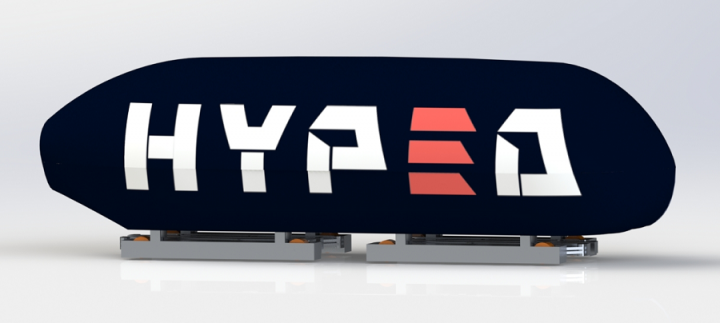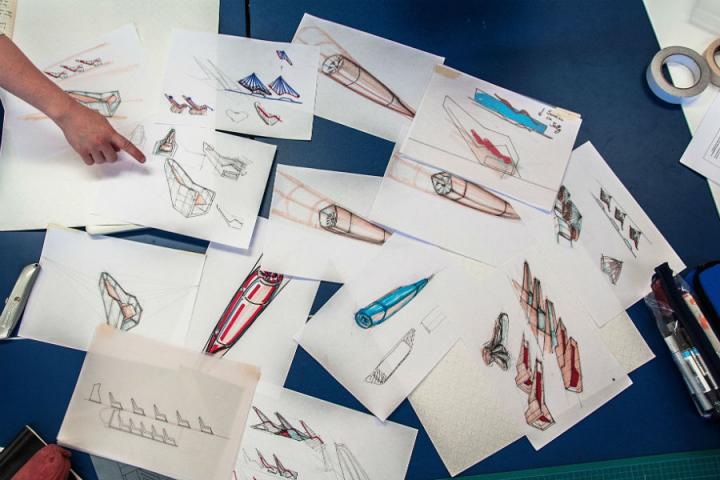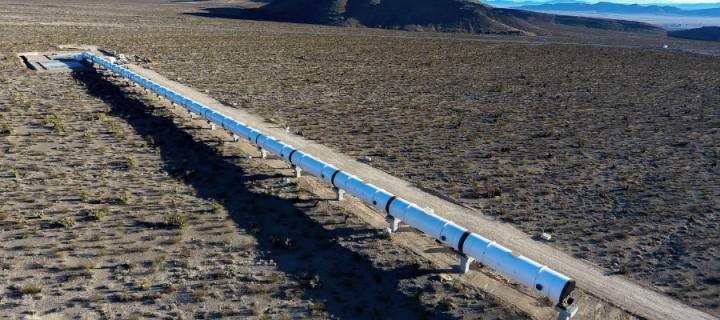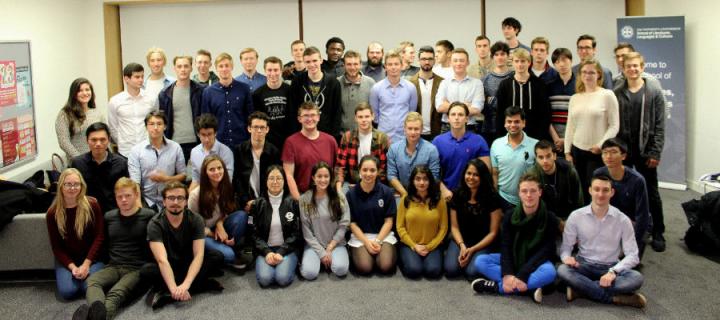Believe the hype
Imagine a world where you can travel the length of the UK in less than an hour, gliding at the speed of sound through a seamless network of overground pipes. This is the vision of a team of talented Edinburgh students who have reached the final stages of not one but two international competitions to develop a new mode of transport called Hyperloop. Adam Anyszewski, 4th-year Engineering student and president of HypED, tells the story of the team’s inspiring journey so far.

Picture this: it’s 2035, you’re living in Edinburgh and have a meeting in London at 9am. You head to Waverley Station to catch the 8am Hyperloop; where you will sit in a capsule which will move at 750mph through a nearvacuum tube, getting you to Kings Cross for 8.30am. Thirty minutes to spare. That’s how we at HypED see the future. And this dream of transforming transportation is now starting to become a reality.

The start of an exciting journey
Our journey began more than four years ago, when Elon Musk, world-renowned inventor and Chief Executive Officer of Tesla and SpaceX, published a 57-page white paper entitled Hyperloop Alpha aimed at ‘revolutionising terrestrial transportation’. For Musk, who came up with the idea while stuck in a traffic jam on his way to work one day, Hyperloop is the future. It combines aspects of the four traditional modes of transport but goes above and beyond.
The Hyperloop system comprises three main components: tube, pods and stations. The tube’s near-vacuum environment allows the pod to travel with very little resistance. Once the pod enters the tube at a station, it is initially accelerated by linear induction motors, but for the most part of the journey it is coasting on passive magnetic levitation, hence power consumption is brought down to minimum. Even at the braking phase there is no physical friction as the pod slows down by utilising eddy currents.
Our team’s proposed route will connect the most densely populated areas across the United Kingdom: Edinburgh, Manchester, Birmingham and London. One pod will carry up to 28 passengers and pods will be able to depart from stations as often as every 30 seconds on the same route. The steel tubes will be built in pairs for both directions of travel and will likely be suspended at a few metres’ height by concrete pylons. Nevertheless, the possibility of fully or partly underground tubes is also being considered.
As soon as Musk released his Hyperloop Alpha paper, discussions and debates began. He decided that neither SpaceX nor Tesla would work on the development and instead made it an open concept for people to develop. Two years later, in June 2015, SpaceX announced a competition for both university and commercial teams to play a part in the development of Hyperloop, allowing the teams the chance to present their ideas and try them out on a custom-built test track, approximately one mile in length with a six-foot outer diameter, in California. Hyperloop was no longer a fantasy but a real possibility.

Creating the HypED team
Immediately after the announcement, engineering students, including myself, at the University of Edinburgh got excited. A group of us got together and soon enough the HypED team was born, giving us an opportunity to create this incredible next mode of transport.
Despite being a group of just over 20 students we sensed that we needed to be more interdisciplinary. Hyperloop was more than a technical idea, it was also about passenger experience and looking at government objectives for the future of green transport. Seven students from Edinburgh College of Art came on board to create a comfortable and enjoyable passenger experience. Everything from how a passenger would get into the pod and the design of the interior, to chair shape and temperature control was considered. Our team, which had now grown to 30 students, submitted our proposal to SpaceX in October 2015.
Of the 1,200 teams from around the world that submitted a preliminary design brief to SpaceX, just 120 were accepted and invited to a Design Weekend in Texas in January 2016. HypED was one of them. Autumn flew by quickly and work continued right through Christmas, and early in the new year 20 members of HypED were flying out to Texas.
The Design Weekend was to be a stepping-stone to the final competition in August 2016 in California. We submitted our 50-page proposal and gave two presentations: on the general idea and modularity. Our presentation on modularity and passenger experience saw HypED awarded a Subsystem Technical Excellence Award, one of only 13 special awards, and a $1,000 donation from the Texas IAM (International Association of Machinists & Aerospace Workers). Despite this incredible experience, which helped the team to develop its technical, presentation and sales skills and grow great friendships along the way, HypED did not get through to the next stage in California at this point.
Back on Scottish soil, we regrouped as a team and decided that we shouldn’t give up. Rather, we had to go bigger! We had to ensure that if anyone spoke about Hyperloop in the UK that it all traced back to HypED and the University of Edinburgh. For HypED to achieve this we needed structure, funding and to be recognised as an official University society – allowing us to gain strong support from the University.

Making progress
Soon enough, another company called Hyperloop One announced a new competition – the Hyperloop One Global Challenge – allowing teams to present the most feasible place for the world’s first Hyperloop. This was HypED’s chance to get our dream route of Edinburgh to London on the map. The team grew to 50 students from various disciplines across the University, including engineering, business, art and law. This collaboration of students allowed all angles of the Hyperloop problem to be looked at in close detail.
We started to spread the word about HypEd’s endeavours. The team decided to run a marketing campaign in October 2016, getting people from across Edinburgh photographed holding huge tickets for our proposed Edinburgh to London Hyperloop. We made links with government officials and transport experts to look at the many different problems that would be solved if the route were to be implemented into the UK. Our hard work led us to be invited to Amsterdam to present our route in the semi-finals of the competition in June 2017.
Things did not quieten down for HypED’s technical team either. SpaceX announced that they were going to run the Hyperloop Pod Competition again. Realising the scope and opportunities that the competition brought and having learnt from the previous year’s mistakes, HypED started looking for sponsors and we were lucky enough to secure a deal with Cirrus Logic, who donated £12,000 to the project. This was game changing and would allow us to develop a prototype of the pod.

A big break
The work did not stop and HypED took precedence over everything. By February 2017, we had a 120-page proposal ready for SpaceX. The proposal was accepted and on 16 March the team gave a presentation via Skype, after which we waited eagerly for feedback. HypED at this point had gathered up a lot of momentum and were grateful to receive support from Professors Gordon Masterton and Win Rampen at the University.
Emails were constantly checked for a response about our presentation and SpaceX’s website was kept under a close watch for updates, and after what felt like the longest fortnight in existence, the answer we’d been hoping for came through – our team, along with 24 other teams, had been invited out to California on 25 to 27 August.
HypED is the only British team (one of four European teams) in the final of one of the most prestigious and inspiring engineering competitions in the world. Everyone in the team is now busy with final preparations to showcase the pod prototype, proudly named Poddy McPodface, to SpaceX in California, and our Edinburgh to London route feasibility to Hyperloop One in Amsterdam.
HypEd is a group of young students focused on the bigger picture of Hyperloop and our commitment is demonstrated by our unique choice to develop cases in both the technical and commercial competitions. We are millennials aiming to make a real impact on a future technology that we want to implement right here in the UK and across the globe. We are united under one dream solution – a world where people and countries are more connected. Four years of hard work is starting to pay off and we’re still HypED!
Video
Footage taken aboard the SpaceX test vehicle, which accelerates the student pods up to speed.
Find out more
For the latest developments, visit the team's Facebook page.
If you'd like to get in touch, email the team.

